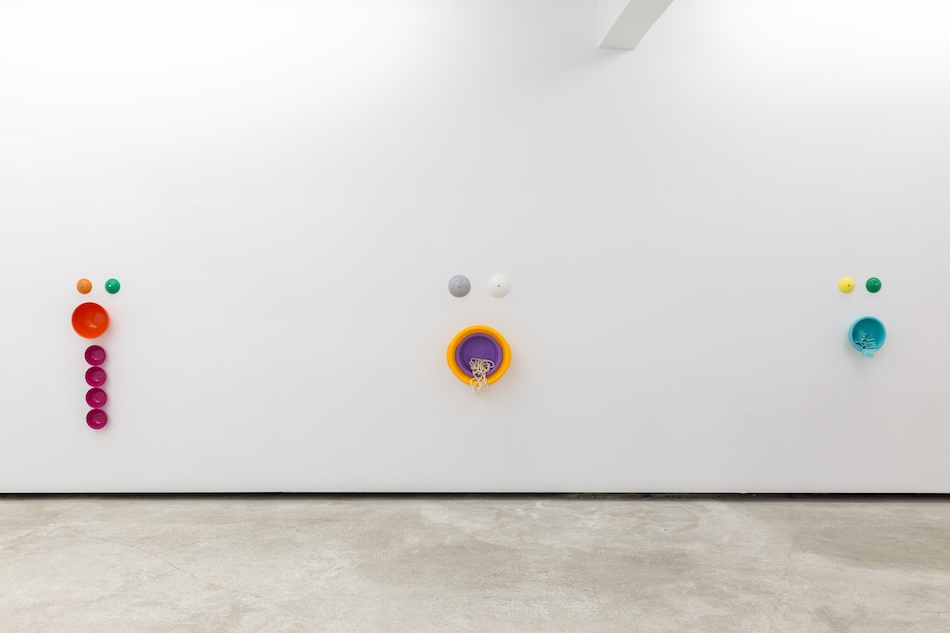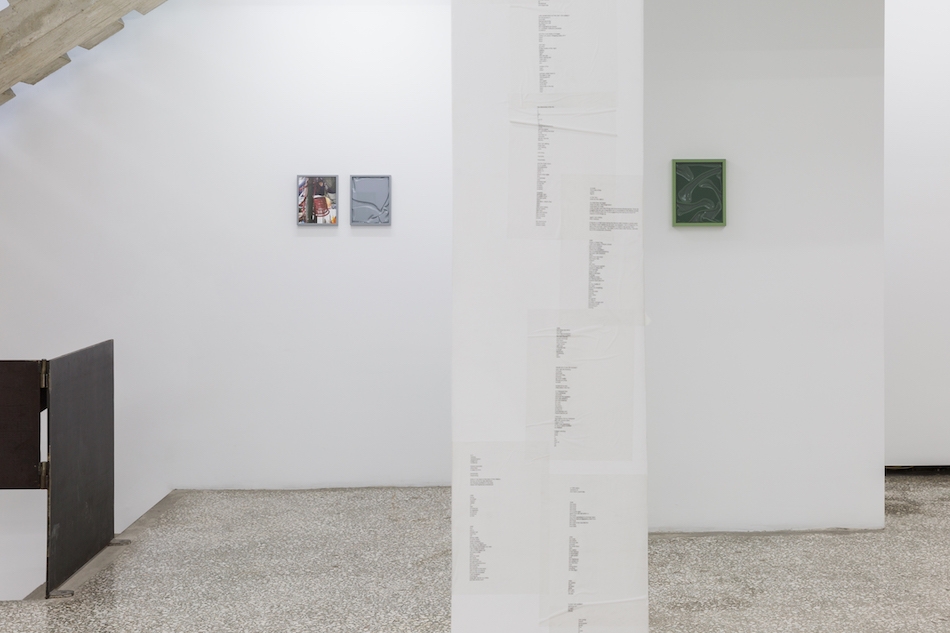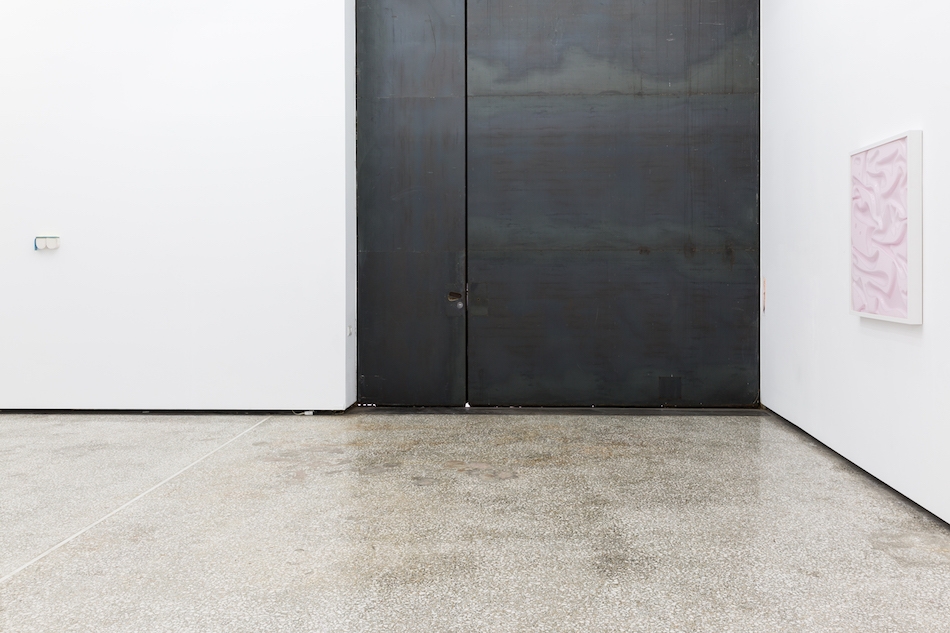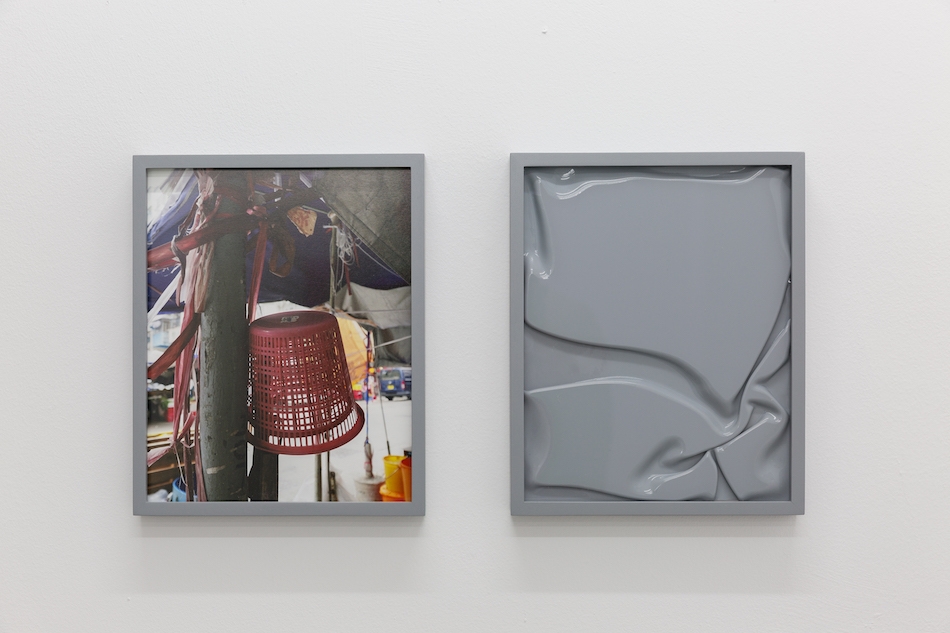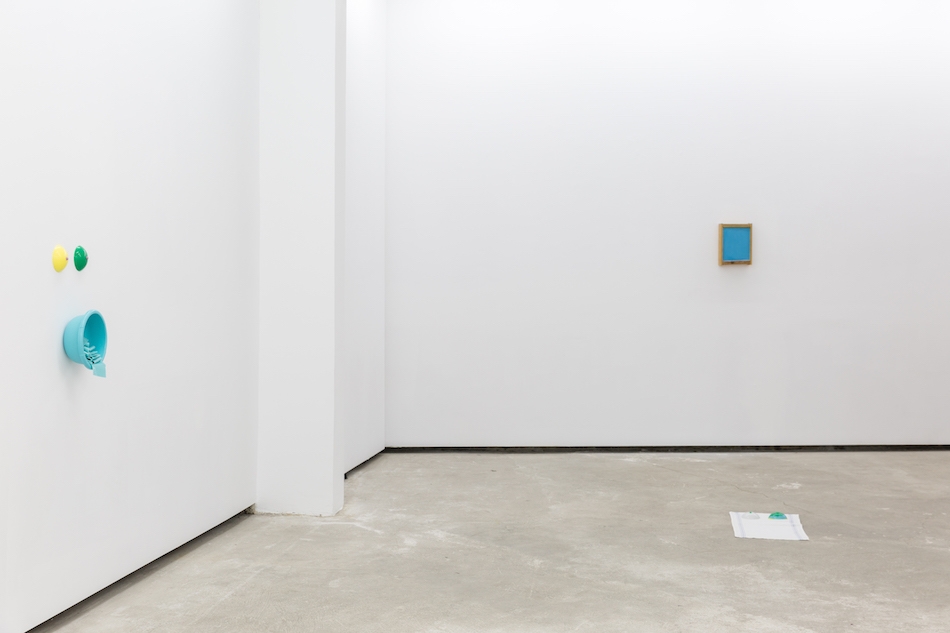Vanessa Safavi
Turns and Returned
May 31, 2018–August 31, 2018The Breeder, Athens
An image of an anonymous blonde woman in a plane is juxtaposed with a little frame of what seems to be a folded silicone sheet. Next to them an image of a plastic bucket hanging on a street market is paired with a grey plastic sheet of silicone. For her third solo show at the gallery Vanessa Safavi proposes recent sculptural and photographic works including these silicone framed monochromes combined together with an image investigating the ephemerality of an event.
The artist chose her color panel by building up associations. Her concerns are fundamentally experimental. Safavi’s interests lay in the accidental and ephemeral nature of things and the observation of their natural particularities, such as color. Her approach creates different observation angles, associating a sheet of silicone with an image of a plastic bucket. If the color of the silicone remains in the image of the bucket, she delicately suggests its physical encounter. The ephemeral event draws with and within the space. Safavi takes The Breeder’s surprising architecture as a tool using the corners, the wide openings and the lower parts for their particularities to emphasize the space’s own narration.
The series of assemblages of different materials such as concrete, wood, plaster and layers of colored silicone strips result from working within a limited field of materials and actions, which the artist collects around her home or while traveling, made and arranged in her studio. Simple forms are simple gestures and create a fundamental visual vocabulary borrowing impressions of architecture and surfaces. Back and forth, turns and come-backs are symbollically simulated by colorful silicone strips. These works reflect the intimacy of thought and an attempt to work through materials, in search of an event in constant circulation and fluctuation.
The colors play a very important part is Safavi’s work and result mostly from her travel impressions but also borrowed from contemporary culture. They belong to a subtil system she organizes ingeniously. Color and materials hold social and cultural meanings; her silicone based works attest that precisely. However, the materiality of the silicone and its folded skin-like characteristic suggests also a living breath that it is alive and that sweat air bubbles. A little blue monochrome (silicone) titled “Untitled” (after Courbet’s blue), 2014 refers to Courbet famous seascapes. Untitled (Notebook 2010-2012), 2013 was the artist notebook between 2010 to 2012. Safavi is equally interested in the monochromic yellow and the weight of words that figure in the book. The artist intentionally drilled a hole through the book and placed a little mirror in the back cover that one can reflect its own image while looking at it. Once again, that work depicts the notion of travels and strates, the returns and come back is emphasized and pilled through the layers of the paper.
A few floor and wall pieces show “naively shaped” silicone breasts and plastic buckets that the artist commonly uses for the making of her sculptures. Forming oversized vaginas and bellies, these fragmented body-parts ironically increase female stereotype. Titled “Uterine Furies” Safavi refers to the famous Sèvres porcelain milk bowl, complete with a nipple made in 1788 as part of a 65-piece dining set that Louis XVI commissioned for his queen, Marie Antoinette, to use at the royal dairy at the Château de Rambouillet. There were a set of four Breast cups made for drinking milk from. These late 18th-century Sèvres breast cups are modeled after a Greek drinking cup produced by Athenian potters, a mastos (meaning breast, udder), made from terracotta in the shape of a female breast, with nipple.
During the Age of Sensibility the aristocracy and Marie Antoinette longed for a simpler life. They looked to a Romanticized peasant life. Marie-Antoinette’s laiterie at Rambouillet, a temple of milk and cheese, was a monument to celebrate peasant life and all that was natural. Also the Breast cups make a reference to breast-feeding. Medical treatises published in this period, many of which were written by physicians attached to the court, encouraged husbands and colleagues to forcibly transplant women to the countryside if they refused to go gently in order to be “cured.” “Uterine furies” was a popular term for the sexually specific form of hysteria or the vapors and its literature is filled with scurrilous accounts of wayward women.
Selected solo shows: “The Cook and the Smoke Detector”, ChertLüdde, Berlin (2017), “Medullla Plaza”, Kunstverein Grafschaft, Bentheim (2016), “Amygdala”, The Breeder Playroom, Athens (2015), “Airbags”, MOTINTERNATIONAL, Brussels (2015), “cloud metal cities”, Kunsthalle São Paulo, Sao Paolo (2014), “La Nuit Liquide” , The Breeder, Athens (2014); “Οne Torino“, Castello di Rivoli, Turin (2013), Kunsthaus Glarus, “After the Monument Comes the People”, Kunsthalle Basel, Basel (2012), “I Wish Blue could be Water”, CRAC Alsace (2012), “Les Figures Autonomes”, Centre Culturel Suisse, Paris (2011).
Selected group shows: Objects like us, The Aldrich Contemporary Art Museum, Ridgefield, ΗΠΑ (2018), Meaning can only grow out of intimacy (Limbs, Water, Nostalgia), curated by Elise Lammer, Les Urbaines – 20th edition, Lausanne (2016), Che il vero possa confutare il falso, AgiVerona Collection, Palazzo Pubblico/Santa Maria della Scala/Accademia dei Fisiocritici, Sienna, curated by Luigi Fassi and Alberto Salvadori (2016), Inflected Objects # 2 Circulation – Mise en Séance, Frans Hals Museum | De Hallen Haarlem, Netherlands (2016), The transparent tortoiseshell and the un-ripe umbrella, Glasgow Sculpture Studios, Glasgow (2016), Swiss Art Awards, Basel (2015), milk revolution, curated by Ilaria Marotta και Andrea Baccin, American Academy, Rome (2015), Emmy Moore’s Journal, curated by Quinn Latimer, SALTS, Basel (2013), Strange Comfort (Afforded by the Profession), curated by Adam Szymczyk and Salvatore Lacagnina in collaboration with Annette Amberg and Roos Gortzak, Kunsthalle Basel, Basel (2010).
